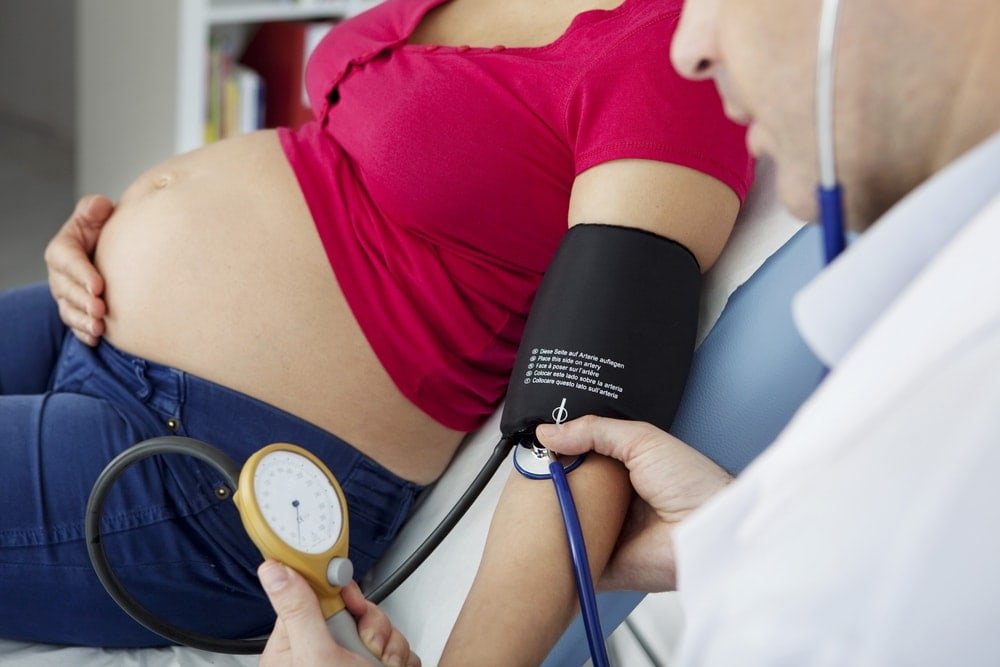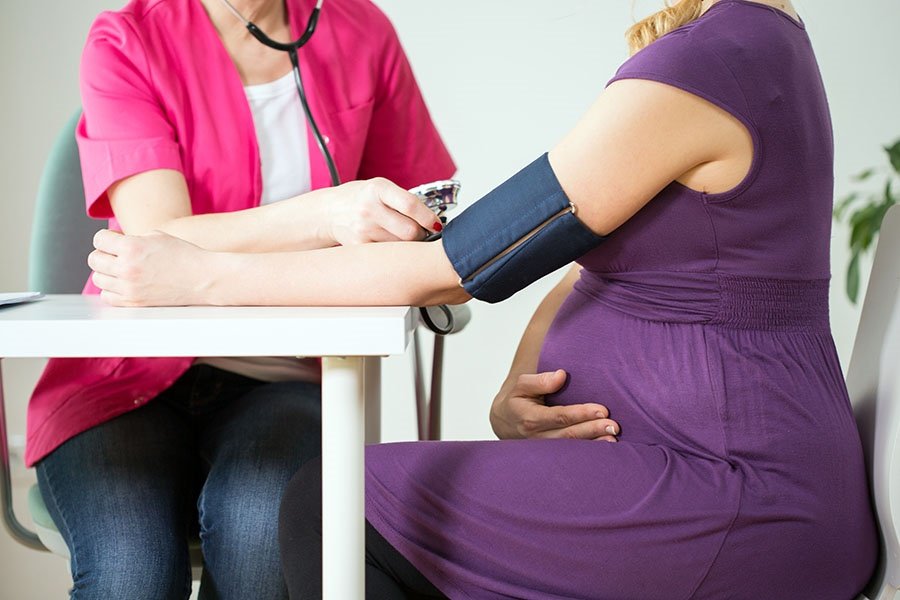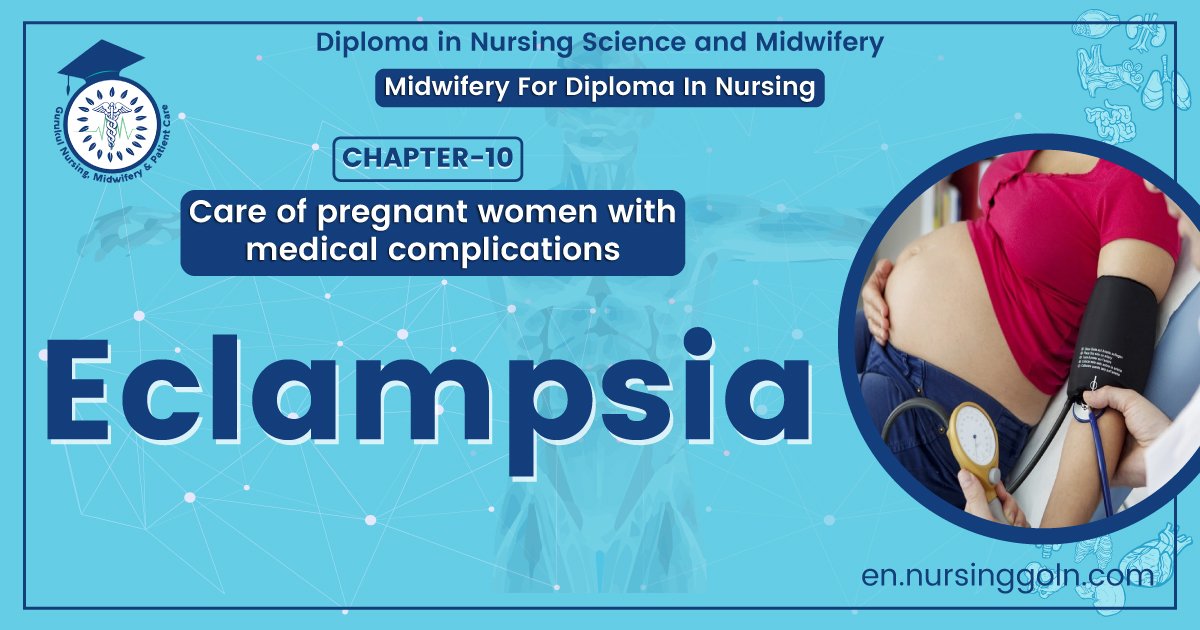Definition of Eclampsia – This course is designed to understand the care of pregnant women and newborn: antenatal, intra-natal and postnatal; breast feeding, family planning, newborn care and ethical issues, The aim of the course is to acquire knowledge and develop competencies regarding midwifery, complicated labour and newborn care including family planning.

Definition of Eclampsia
The occurrence of convulsion in a patient with preeclampsia with no coincident neurological disease.
Or
When Preeclampsia is complicated with convulsion and or coma is called eclampsia.
Stages of Eclampsia:
A. Premonitorv stage:
- The patient becomes unconscious
- Twitching of muscles of face, tongue and limbs
- Eye balls roll or turned to one side and become fixed
- Duration of the state: This stage lasts for about 30 second
B. Tonic stage:
- The whole body goes into spasm
- The trunk becomes opisthotonus, limbs are flexed and hands clenched
- Respiration ceases and the tongue protrudes between the teeth. Cyanosis appears
- Eye balls become fixed
- Duration of the state: This stage lasts for about 30 seconds
C. Colonic stage:
- All the voluntary muscles undergo alternate contraction and relaxation
- Twitching starts in the face then involve one side of the extremities and ultimately the whole body
- Biting of the tongue
- Breathing is stertorous and blood stained frothy secretions fill the mouth
- Cyanosis disappears gradually
- This stage last for 1-4 minutes
D. Stage of coma:
- Following the fit, the patient on to the stage of coma
- Duration of the stage: the fits are usually multiple, recurring at varying intervals. It
- may last for a brief period or in others deep coma persist kill another convulsion
- On occasion, the patient appears to be in a confused state following the fit and fails to remember the happenings
Causes of Convulsion in Pregnancy:
1. Eclampsia.
2. Epilepsy.
3. Hysteria.
4. Encephalitis.
5. Meningitis.
6. Puerperal cerebral thrombosis.
7. Poisoning.
8. Cerebral malaria.
9. Brain tumours.
10. Electrolyte imbalance.
Features of Eclampsia:
1. Headache
2. Epigastric pain, nausea, vomiting
3. Flushing of light before eyes
4. Blurring vision, photophobia
5. Diminished urinary output
6. Disturbance of sleep
7. Swelling of legs
8. Fits
9. H/O convulsion

Clinical Examination:
1. Massive oedema.
2. Continuous rise of BP
3. Gross proteinuria
4. Convulsion
Management of a Case of Eclampsia:
A. Immediate general management:
1. Absolute bed rest in an isolated room in left lateral position is to be taken.
2. Detail history from relatives.
3. Quick examination of the patient: Half hourly prille, IBP and respiration rates.
4. Catheterization by self-retaining catheter.
5. Parenteral of intake output chart.
6. Parenteral antibiotics.
B. Specific management:
1. Anticonvuhant and sedative: Any one of the following regimes are used
>Inj.Diazepam
- Initial dose 10-20 mg IV slowly
- Maintenance dose 40 mg in 500 co 5% DA at a rate of 10-15 d/min for 24 hours
- If convulsion recurs 10 mg IV slowly stat
>Magnesium sulphate (Mg504) regime
| Regimen | Loading dose | Maintenance dose |
| IM (Pritchard) | 4 gm IV over 3-5 min. fallowed by 10gm deep IM (5 gm in rach buttock) | 5 gm. IM-4 hourly in alternate buttock |
| IV (Zaspan or sihal) | 4-6 gm IV over 15-20 min | 1-2 gm/h IV infusiem |
Lytic cocktail regime: (Chlorpromazine Promethazine + pethidine)
- Initial dose: Chlorpromazine 25 mg + Pethidine 100 mg IV stat in20 mi of 5% dextrose
- Maintenance dosr: Pethidine 100 mg in 500 ml 10% DA at a rate of 20- 30 d/min.
- Promethazine 25 mg and chlorpromazine 50 mg at 4 hourly up to 24 hour following last convulsion
2. Anti-hypertensive:
>Parenteral drugs: Hydralazine, labetelol, Ca” channel blocker, etc.
>Oral drugs: o-methyl dopa, labetolol, Nifedipine and hydralazine
C. Management of complication:
1. Pulmonary oedema: diuretics
2. Acute LVF: Diuretics, digoxin, oxygen inhalation
3. Anuria: Diuretics, dialysis etc
D. Obstetric management:
- ARM (Anificial nqture of merobrane followed by oxytocin drip: If cervix in favorable patient is not at lahour and haby is mature
- ARM Sollowed by forceps delivery. If patient in labour and baby is alive
- Caesarean section. If cervix is unfavorable or presence of other indication of carsarean sectam.
Complication of Eclampsia:
A. Maternal complication:
1. Pulmonary complication:
- Pulmonary oedema
- Pneumonia
- Acata respiratory distress syndrome (ARDS)
- Pulmonary emboliam
2. Acute left ventricular failure (ALVF)
3. Acute renal failure (ARF)
4. Cerebral edema and hemorrhage
5. Disturbed vision due to retinal detachment or occipital lobe ischemin
6. Нурегрутехів
7. Post-partum complication: Hemorrhage, Sepsis, psychosis
8. Haematological
- Disseminated intravascular coagulation
- Thrombocytopenia
9. Hepatic: Sub-capsular haematoma, Hepatic necrosis
10. Complications due to convulsion:
- Tongue bite
- Injury due to fall from bed
- Bod sore
11. Others:
- Recurrence
- Residual hypertension
B. Fetal complication
1. Intrauterine death IUD
2. Intrauterine growth retardation
3. Birth asphyxia
4. Prematurity
Causes of Maternal Death in Eclampsia:
1. Cardiac failure
2. Pulmonary oedema
3. Aspiration pneumonia
4. Septic precaminia
5. Cerebral hemorrhage.
6. Acute renal ihre
1. Cardiopulmonary imrest.
8. Adult respiratory distress syndrome (ARDS)
9. Palmonary embolism.
10. Postpartum shock
11. Puerperal sepsis

Prevention of Eclampsia:
A. Prevention of intra-partum eclampsia
- Early detection & effective institutional neatmem with judicious termination of pregnancy during pre-eclampsia
B. Prevention of post-partum eclampsia
- Adequate sedation, anti-hypertensive drugs and/or prophylactic anti-convulsant therapy soon after delivery of the baby in pre-eclaimpsis and meticulous observation for 24-48 hours are the definitive steps to prevent post-partum eclampsia
Read More.
